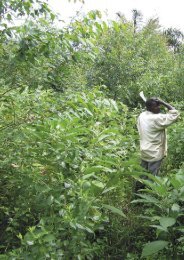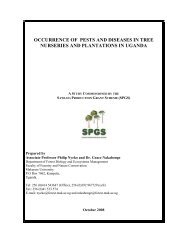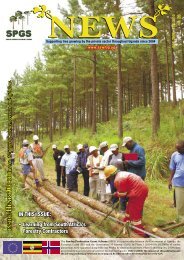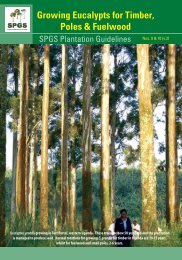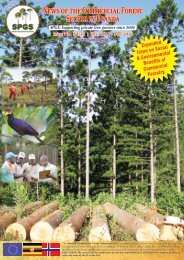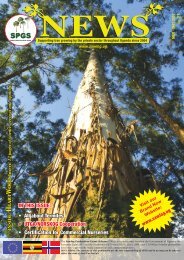You also want an ePaper? Increase the reach of your titles
YUMPU automatically turns print PDFs into web optimized ePapers that Google loves.
HeartWood No. 6 (2010)<br />
LOCAL TERMITE CONTROL STRATEGIES<br />
by Frank Mukalazi<br />
NB. Please note that the practices discussed<br />
in this article are not necessarily endorsed by<br />
<strong>SPGS</strong> but are presented here to add to the<br />
debate and promote research into termites<br />
- the number one pest of eucalypts in the<br />
region – Ed.<br />
INTRODUCTION<br />
The major constraint on productivity of<br />
plantation forestry in Africa is Arthropod<br />
pests. However, very little information is<br />
available on farmers’ perception of such<br />
pests, their control practices and decision<br />
making process in forestry. In contrast,<br />
traditional pest management practices in<br />
forestry have been studied for a number<br />
of cropping systems and the results use<br />
as inputs for developing Integrated Pest<br />
Management (IPM) packages.<br />
As plantation forestry is developed and<br />
promoted, there is a need to integrate local<br />
control strategies about pest identification<br />
and management techniques into the<br />
development process in order to improve<br />
farmers’ pest management practices. This is<br />
because farmers have a long experience of<br />
growing their crops: experience which has<br />
been built up through regular observations<br />
and exchange of information through formal<br />
and informal networks.<br />
TERMITE CONTROL STRATEGIES<br />
Use of cow’s urine and wood ash<br />
Cow’s urine and wood ash are mixed and left<br />
for a period of 2-4 weeks to ferment. During<br />
the fermentation process, toxic substances<br />
to termites are released, which cause death<br />
to termites. The mixture of cow’s urine and<br />
wood ash can be poured in a freshly opened<br />
mound.<br />
Wood ash contains substances toxic or<br />
repellant to termites. Wood ash has been<br />
effective in protecting tree seedlings if<br />
mixed into plant nursery beds or applied<br />
in a layer below polythene planting tubes.<br />
The use of wood ash in termite control has<br />
not been evaluated rigorously and thus its<br />
efficiency remains speculative.<br />
Mechanical destruction of mounds<br />
Mounds can be destroyed by using hand<br />
tools. This is because the nests are readily<br />
identified and royal chamber easy to<br />
locate. Mounds are physically destroyed<br />
and the queen removed. However, young<br />
colonies may remain entirely subterranean<br />
for their first years and thus be difficult to<br />
identify. In addition, if nymphs or alates are<br />
present at time of dequeening, replacement<br />
reproductives may develop. This explains<br />
why de-queened mounds are sometimes<br />
recolonised.<br />
Use of torch batteries<br />
Torch batteries can be used as a termiticide.<br />
The batteries are broken and contents are<br />
missed in appropriate quantities of water.<br />
The resultant solution is then poured into<br />
a freshly opened mound and then covered.<br />
Torch contents can also be poured into mound<br />
without mixing with water. Torch batteries<br />
are believed to contain substances which are<br />
either toxic or repellant to termites.<br />
A common sight in Africa - a termite nest<br />
Use of dead animals<br />
Dead animals such as dogs, snakes etc.<br />
reduce termite attack. A dead body is put<br />
into a freshly opened mound and covered.<br />
During the decomposition of such material,<br />
toxic substances are released which result<br />
into death of termites.<br />
Use of crop residues<br />
Crop residues are burnt into an open mound.<br />
This results into death of queen and alates.<br />
The method is effective, however, the main<br />
drawback of method is that fire may run out<br />
of hand and damage the plantation.<br />
Directing erosion water into mound<br />
During rains, erosion water is directed into<br />
an opened mound. This results into death<br />
of termites.<br />
Use of Fish Bones<br />
Fish bones are put into a freshly opened<br />
mound and then covered. The rationale<br />
behind this method is unclear, but possibly<br />
fish bones may contain substances toxic or<br />
repellent to termites.<br />
Use of Hot Water<br />
Hot water is poured into a freshly opened<br />
mound which results into killing of the<br />
queen and termites. The method is effective,<br />
however, it is also risky since one can easily<br />
get burnt with hot water.<br />
CONCLUSIONS<br />
A variety of approaches such as dead snakes<br />
and other animal products are used by<br />
farmers to encourage termite predation in<br />
mounds. This provides clear evidence that<br />
the farmers’ indigenous technical knowledge<br />
(ITK), if not misunderstood or misperceived,<br />
could be utilized to develop novel termite<br />
management strategies. Some of the termite<br />
management strategies used by farmers are<br />
dangerous both to themselves (farmers) and<br />
environment. Such strategies need to be<br />
revised.<br />
REFERENCES:<br />
Mukalazi K.F. (2008). Farmers’ knowledge,<br />
perceptions and control of termites<br />
in Eucalyptus woodlots. Makerere<br />
University, Kampala. 42pp.<br />
Nyeko P. and Olubayo F.M. (2005).<br />
Participatory assessment of farmers’<br />
experiences on termite problems in<br />
agroforestry in Tororo District, Uganda.<br />
Agricultural Research and Extension<br />
Paper No. 143.<br />
About the Author: Mukalazi K. Frank<br />
is is Technical Advisor of Nkambo<br />
Forestry Company, Tukusinza Forest and<br />
Rugarama Enterprise in Rukungiri. He<br />
holds a BSc. In Forestry from Makerere<br />
University. Mukalazi K. Frank has five<br />
years of experience in forestry work. He<br />
is also a Senior Biology Teacher at Light<br />
Secondary School, Bulenga.<br />
Contact: P.O. Box 4272, Kampala (U),<br />
Tel: 0782-774297.Z<br />
5



